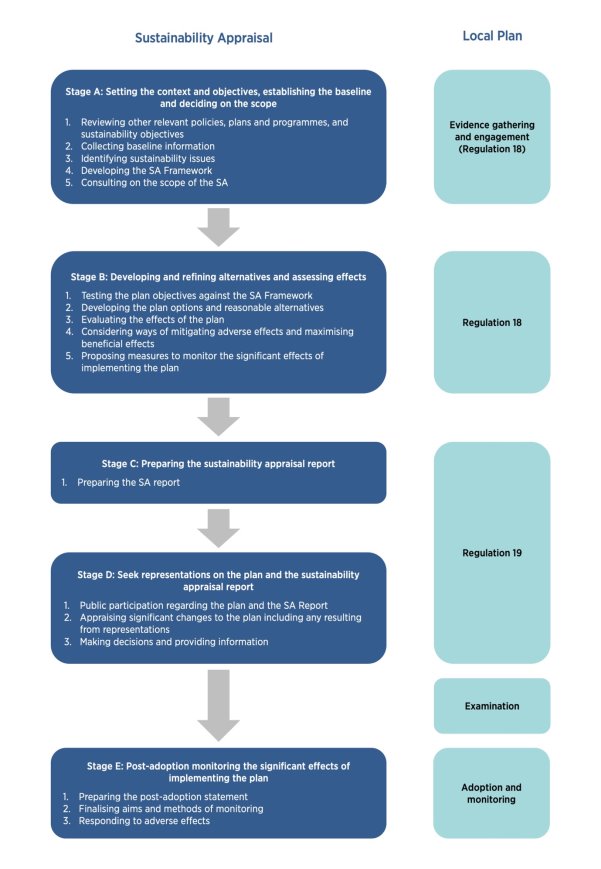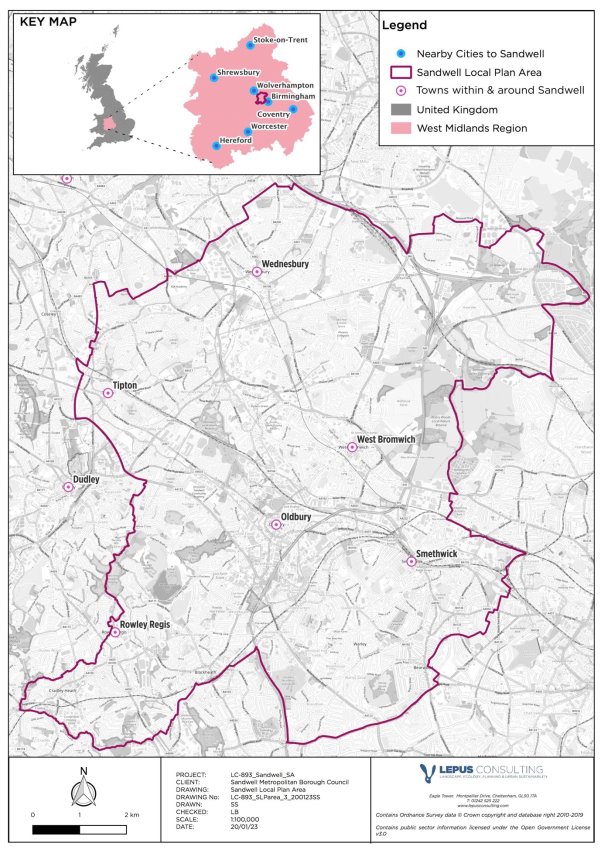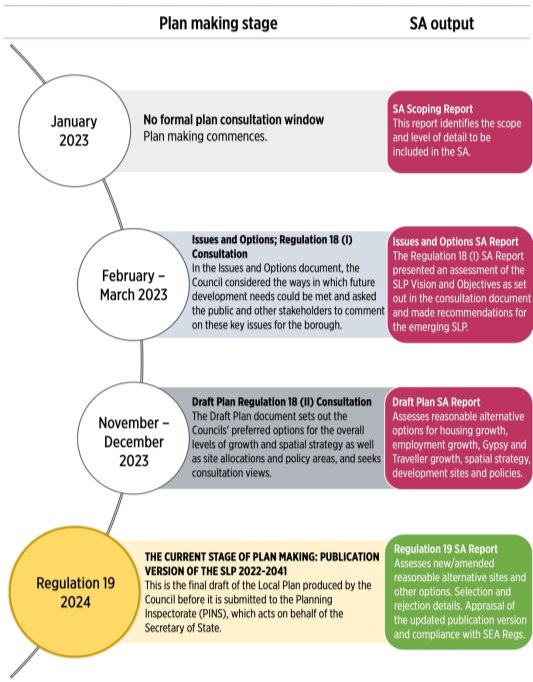Sustainability Appraisal of the Sandwell Local Plan 2024-2041
Non-Technical Summary
(2) 1 Introduction
The purpose of this report
N1 Lepus Consulting Ltd (Lepus) has been instructed by Sandwell Metropolitan Borough Council (SMBC) to undertake a Sustainability Appraisal (SA) process, incorporating the requirements of Strategic Environmental Assessment (SEA), for the Sandwell Local Plan (2024-2041).
N2 The Regulation 19 SA Report has been prepared to present full details of the SA process to date and inform SMBC's preparation of the Sandwell Local Plan.
N3 This document comprises a Non-Technical Summary (NTS) of the Regulation 19 SA for the Sandwell Local Plan, which presents an assessment of the likely sustainability impacts of proposals set out in the Plan. This NTS document comprises Volume 1 of the SA; it is accompanied by Volume 2: The Main SA Report and Volume 3: Appendices to the main SA Report.
The Sandwell Local Plan
N4 The UK Government requires that local plans should be reviewed every five years and updated as necessary. The Sandwell Local Plan (SLP) will include the overall strategy for development in Sandwell Metropolitan Borough for the Plan period 2022 to 2041, including a vision for Sandwell in 2041 and underpinning strategic objectives, and an overall spatial strategy supported by site allocations and policies to guide land use and development within the borough.
N5 The SLP vision and objectives were drafted by SMBC, employing the principles of the extant Council Vision and the direction of travel set out within the Black Country Plan (BCP). The vision and objectives were both subject to public consultation and comments made during this period have been taken into account. In addition, the SLP SA and subsequent comments have also been considered and have been used to make the reflect sustainability issues, such as the circular economy, within the vision.
What is Sustainability Appraisal and Strategic Environmental Assessment?
N6 The Planning and Compulsory Purchase Act[1] requires a sustainability appraisal to be carried out on development plan documents in the UK. Additionally, the Environmental Assessment of Plans and Programmes Regulations[2] (SEA Regulations) require an SEA to be prepared for a wide range of plans and programmes, including development plan documents, to ensure that environmental issues are fully integrated and addressed during decision-making.
N7 SA is the process of informing and influencing the preparation of a local plan or development plan document to optimise its sustainability. SA considers the social, economic and environmental performance of the plan. The SA (and SEA) can help to ensure that proposals in the plan are appropriate given the reasonable alternatives. It can be used to test the evidence underpinning the plan and help to demonstrate how the tests of soundness have been met. SA should be applied as an iterative process informing the plan throughout its development.
N8 Sustainability can be defined as "meeting the needs of the present generation without compromising the ability of future generations to meet their own needs"[3]. To be sustainable, development requires the integration of the needs of society, the economy and the environment (see Figure N.1).
Figure N.1: Sustainable development
N9 The Sandwell Local Plan is at the plan-making stage Regulation 19, known as 'Publication' in the Local Plan Regulations 2012[4], as shown in Stage C of Figure N.2.

Figure N.2: Sustainability Appraisal and Local Plan process
Sandwell Metropolitan Borough
N10 Sandwell is a metropolitan borough covering approximately 8,556ha, with a population of 341,900 according to the Census (2021)[5]. On average, Sandwell has a younger and more ethnically diverse population than the rest of the UK. Deprivation and inequalities are key issues for the local population, Sandwell is one of the most deprived local authorities in England with approximately 25.5% of children living in low-income families and life expectancy for both men and women lower than the national average.
N11 Sandwell lies within the Black Country, which is a predominantly urban sub-region of the West Midlands. The sub-region includes the boroughs of Dudley, Sandwell, Walsall and the City of Wolverhampton. The location of Sandwell is shown in Figure N.3.
N12 The strategic centre of Sandwell is West Bromwich, with several other main towns and centres including Bearwood, Blackheath, Cape Hill, Cradley Heath, Great Bridge, Oldbury and Wednesbury, alongside smaller towns and settlements. Sandwell's towns are well connected through a network of strategic transport routes, with links to other regional and national centres via the M5/M6 and rail corridors.
N13 Industry and manufacturing form a key part of Sandwell's history, which continues in the local economy today as Sandwell is an important centre in particular for retail and wholesale, manufacturing, and health and social care sectors. Sandwell also plays a role within the wider economy in terms of electricity, gas and air conditioning as well as water supply and waste management, and transportation and storage industries. The borough also supports a range of parks and open spaces including the Rowley Hills and Sandwell Valley. The Sandwell Valley forms Sandwell's only area of Green Belt land.

Figure N.3: Map of Sandwell Metropolitan Borough
The SA process alongside the Sandwell Local Plan
N14 Figure N.4 provides an overview of the stages that have been undertaken during the preparation of the Local Plan and the accompanying SA outputs and summarises the purpose and content of each.
N15 Each stage included consultation with the statutory bodies for SA/SEA: Historic England, Natural England and the Environment Agency. Comments received were taken into consideration during the preparation of the SA outputs.

Figure N.4: Stages in the plan-making process accompanied by SA outputs
Scoping
N16 The preparation of a Scoping Report was the first phase of the SA process. The scoping process set the criteria for assessment (including the SA Objectives) and established the baseline data including a review of relevant policies, programmes and plans (PPPs). The scoping process involved an overview of key issues, highlighting areas of potential conflict. The SA Scoping Report was prepared by Lepus Consulting in 2023[6].
N17 Between in February and March 2023, the content of the SA Scoping Report was consulted on with Historic England, Natural England, the Environment Agency and other relevant bodies. No specific comments were received regarding the SA Scoping Report.
Regulation 18
N18 The Regulation 18 (I) Issues and Options SA Report (January 2023)[7] identified options for the Vision and 11 draft Objectives for the SLP. The SA Report also set out a range of recommendations for SMBC to consider as the SLP is developed and refined, including recommendations to improve the SLP Vision and Objectives, as well as consideration of the identification, description and evaluation of reasonable alternatives which is an important aspect of this Regulation 18 (I) SA Report.
N19 The Regulation 18 (II) Draft Plan SA report (October 2023)[8] set out the appraisal of four spatial growth options alongside six housing growth options, four employment growth options, and three options for Gypsy and Traveller growth. These spatial options constitute reasonable alternatives for the distribution of new housing growth in the Plan area. Additionally, the Regulation 18 (II) SA included an assessment of 18 draft objectives for the SLP, 87 draft policies and 120 reasonable alternative sites. The SA report also set out the Council's preliminary reasons for selecting and rejecting reasonable alternative sites. Reasonable alternatives are discussed further within Chapter 5 of the main report.
Regulation 19
N20 The Regulation 19 SA Report (this report) includes a summary of the SA process to date and has been prepared to help inform the examination stage of the preparation of the SLP. The SA Report has been prepared to meet the requirements of an SEA Environmental Report. It also sets out the assessment of additional and amended reasonable alternative sites that have been identified by SMBC since the Regulation 18 stage. There are six housing growth options, four employment growth options, three Gypsy and Traveller growth options, four spatial growth options and 124 development sites which have been assessed throughout the SA process.
[1] Planning and Compulsory Purchase Act 2004. Available at: https://www.legislation.gov.uk/ukpga/2004/5/contents [Date Accessed: 28/08/24]
[2] The Environmental Assessment of Plans and Programmes Regulations 2004. Available at: http://www.legislation.gov.uk/uksi/2004/1633/contents/made [Date Accessed: 28/08/24]
[3] Brundtland (1987) Report of the World Commission on Environment and Development: Our Common Future. Available at: http://www.un-documents.net/our-common-future.pdf [Date accessed: 28/08/24]
[4] The Town and Country Planning (Local Planning) (England) Regulations 2012. SI 767
[5] Office for National Statistics (2022) How the population changed in Sandwell: Census 2021. Available at: https://www.ons.gov.uk/visualisations/censuspopulationchange/E08000028/ [Date accessed: 28/08/24]
[6]Lepus Consulting (2023) Sustainability Appraisal of the Sandwell Local Plan: Scoping Report. Available at: https://www.sandwell.gov.uk/downloads/file/896/sandwell-local-plan-issues-and-options-sustainability-appraisal-scoping-report [Date accessed: 28/08/24]
[7]Lepus Consulting (2023) Sustainability Appraisal of the Sandwell Local Plan – Regulation 18: Issues and Options, January 2023. Available at: https://www.sandwell.gov.uk/downloads/file/893/sandwell-local-plan-issues-and-options-sustainability-appraisal [Date accessed: 28/08/24]
[8] Lepus Consulting (2023) Sustainability Appraisal of the Sandwell Local Plan – Regulation 18: Draft Plan, October 2023. Available at: https://sandwell.oc2.uk/document/9 [Date accessed: 28/08/24]
